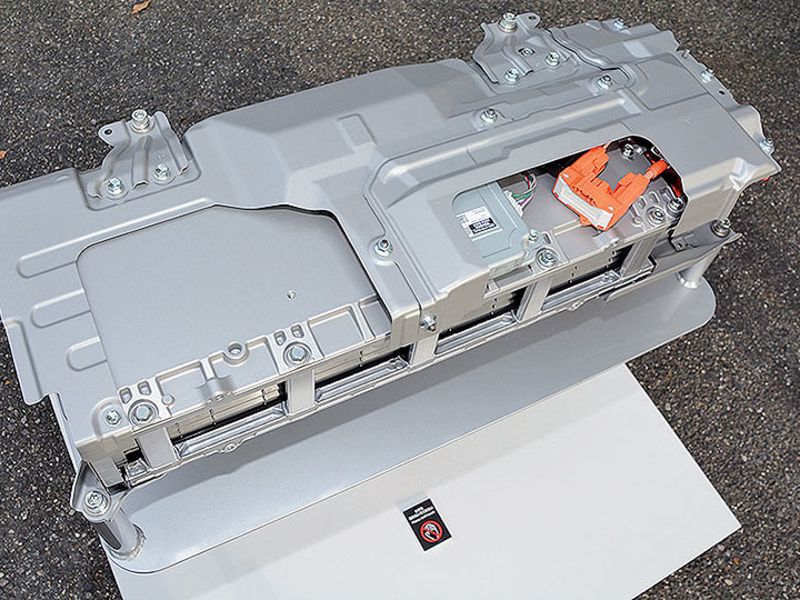
TOKYO — In a world where lithium ion power packs are the norm and buzz is building around solid-state batteries, old nickel-metal hydride batteries seem like yesterday’s news.
After all, Toyota has been using the chemistry since the 1997 launch of the Prius hybrid.
But engineers at Toyota have found a way to squeeze more juice out of the old tried-and-true battery technology, and it is giving Toyota’s latest hybrids a new life in the electric vehicle age.
Toyota calls its innovation the bipolar nickel-metal hydride battery. A new structural design delivers not only a more powerful battery, but one that is much more compact — essentially doubling its power density while using the same basic chemistry.
Toyota deployed the new battery this year in the redesigned compact Prius C hybrid. Each cell delivers 1.5 times the output of the old setup, and the structure allows for 1.4 times as many cells in the same space.
“If we use the same space, we are able to fit a battery that has twice the output,” said Motoyoshi Okumura, group manager of Toyota’s advanced battery development division. His team started working on the new battery architecture in 2016 and expects to ramp up deployment.
The innovation is helping Toyota keep hybrid vehicles relevant, competitive and affordable as much of the industry splurges on lithium ion battery capacity for full-electric vehicles. Toyota aims to sell 8 million electrified vehicles in 2030. But only 2 million of those will be EVs or fuel cell vehicles; some 6 million vehicles will be traditional hybrids and plug-ins.
For context, Toyota sells only about 2 million hybrids a year today.
To power those vehicles, Toyota is investingin battery development through 2030, to secure 200 gigawatt-hours of battery supply by the end of the decade.
Toyota will keep using the traditional nickel-metal hydride batteries, but it will increasingly ramp up deployment of the bipolar version as the automaker adds new models through 2030. “We will look more proactively to adopt this new battery,” Okumura said.
Bipolar batteries eke better performance by combining the anode and cathode terminals into the same current collector. Before, the anodes and cathodes had their own collectors.
The new arrangement not only saves space, it delivers a larger current of electricity.
At scale, the cost of making the batteries is lower because they have fewer components. But right now, output is limited. The bipolar batteries are manufactured by group affiliate Toyota Industries Corp., which has only enough capacity currently for 240,000 vehicles a year.
For traditional nickel-metal hydride batteries, by contrast, Toyota sources some 1.6 million units a year, primarily from Primearth EV Energy Co. in Japan, as well as sources in China.
Okumura said it’s a misconception to think that nickel-metal hydride batteries are old and lithium ion batteries are new. Development of the two types started around the same time, he said. But it just so happens that nickel-metal hydride made it to market first.
“The public has the image that nickel-metal hydride batteries are an old battery, but actually they’re not,” Okumura said. “We started developing this new type of nickel-metal hydride battery because, after 20 years of using it, there was a record of achievement.
“But the basic design has not changed significantly,” he said. “So we decided to take on the challenge of increasing the output.”
Because of the strong current and output, the new batteries are best suited for hybrid vehicles that require quick bursts of power, as opposed to EVs that need a large energy store.
Toyota is positioning lithium ion as its main EV battery. But Toyota believes the bipolar structure could also be applied to lithium ion batteries, leading to potential improvements in those power packs.
The automaker’s 2030 road map calls for developing a new generation of lithium ion batteries in the latter half of the 2020s, in addition to solid-state batteries.
That fits Toyota’s strategy of developing different batteries with different performance characteristics to best match the driving characteristics of the vehicles in which they are used.
“In achieving carbon neutrality, it is very important to maintain a wide variety of options,” Okumura said. “So it is important that we do R&D on a wide variety of battery types.”